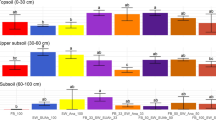Abstract
The hill to hill variation in tuber yield and mainstem number was studied on 18 potato farms. There were up to 14-fold differences in the tuber yield per hill among plants of Norland, Russet Burbank, Norchip, Carlton and Alaska Red. The mainstem number was more variable than tuber weight per hill in Norland, Russet Burbank and Alaska Red. However, the opposite was true in Norchip and Carlton. In nearly all comparisons, the number of tubers per hill was less variable than tuber weight and mainstem number per hill. The total variation in tuber weight found in about 50% of the samples could be explained by the variance of hills within rows. Even in samples where an added variance component due to differences among rows was present, relatively more variation occurred within than among rows.
The correlation coefficients between the number of mainstems and tuber weight per hill were positive but significant (P&< 0.05) only in Norland and Norchip. The correlation coefficients between the number of mainstems and number of tubers per hill were also positive but slightly higher and significant (P<0.01) in all 5 cultivars. The coefficient of determination values indicated that variation in cut seed piece weight explained only about 10% of the total variation in tuber weight harvested per hill. At a spacing of 30 cm within the row, a major proportion of hill to hill variation in tuber yield had to be explained by factors other than the seed piece weight.
Similar content being viewed by others
Literature Cited
Andrew, W.T., I. Soliman and T.A. Preston. 1970. The influence of simulated gaps on yield of potatoes. Proc Alberta Potato Commission. pp. 96–104.
Blodgett, F.M. 1941. A method for the determination of losses due to diseased or missing plants. Am Potato J 18:133–135.
Chucka, J.A. 1945. Size of whole and cut seed spacing in relation to potato yields. Maine Agric Exp Stn Bull. p. 439.
Gilbert, N.E. 1974. Biometrical interpretation. Oxford University Press, London.
Iritani, W.M., R. Thornton, L. Weiler and G. O’Leary. 1972. Relationships of seed size, spacing, stem number to yield of Russet Burbank potatoes. Am Potato J 49:463–469.
James, W.C., C.H. Lawrence and C.S. Shih. 1973. Yield losses due to missing plants in potato crops. Am Potato J 50:345–352.
Reestman, A.J. and C.T. De Wit. 1959. Yield and size distribution of potatoes as influenced by seed rate. Neth J Agric Sci 7:257–268.
Sokal, R.R. and F.J. Rohlf. 1969. Biometry. W.H. Freeman and Co., San Francisco.
Svensson, B. 1966. Seed tuber-stand-yield. Properties and relationships. Pl Husbandry Pub 21. Agric Univ of Sweden, Uppsala.
Tuthill, C.S. and P. Decker. 1941. Losses in yield caused by leaf roll of potatoes. Am Potato J 18:136–139.
Author information
Authors and Affiliations
Rights and permissions
About this article
Cite this article
Silva, G.H., Andrew, W.T. Hill to hill variations in tuber yield of potatoes in Alberta. American Potato Journal 62, 119–127 (1985). https://doi.org/10.1007/BF02871340
Accepted:
Issue Date:
DOI: https://doi.org/10.1007/BF02871340




